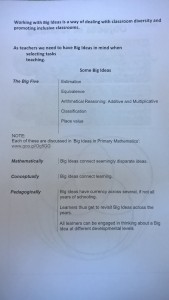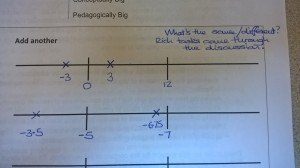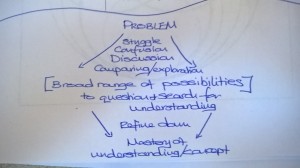Our staff had a fascinating day of professional learning and reflection with colleagues from other schools listening to, exploring with and learning from Mike Askew (@mikeaskew26) yesterday.
Mike was helping us to think about the Big Ideas in maths, and by considering how we can develop these and adapt our ways of structuring, supporting pupils’ thinking, understanding and learning we can have major positive impacts for individuals and schools.
“We know that learning mathematics is more powerful, deeper and longer lasting when children make connections between different mathematical ideas.” (Mike Askew).
Mike discussed the variance of pupils’ capabilities (not abilities) on entry to primary school, which for the vast majority is based on home and pre-school experiences (much like variance in spoken vocabulary on entrance to primary). The aim should be by the age of 6 or 7 that this gap has been narrowed through focused thinking and learning mathematical experiences. This links with the principle of the new NC of the vast majority of pupils achieving end of year expectations and the notion of “catch up / keep up” which many people are talking about.
Mike also talked about immersing the learners in key ideas for a long time to ensure time for exploration and development of understanding to enable fluency, mathematical reasoning and problem solving capabilities and mindset. Again this links to the new NC premise of “fewer things in greater depth”.
We discussed the need to continue to use concrete and pictorial resources and strategies through primary, as opposed to some teachers view that once in Key Stage 2, particularly upper Key Stage 2, that learners should have moved beyond these supports. However Mike also showed that younger children are able to work in abstract ways effectively as well.
Mike showed the importance of teachers putting careful thought into choosing examples of problems, how they are represented and the wording of information and questions. He demonstrated that by giving:
- learners time to explore and solve a problem or question in pairs,
- using a visualiser to show a pupils’ example,
- asking the pairs to try and work out what that pupil was thinking and to explain their reasoning
- asking the pupil to explain their thinking
- asking another pupil to articulate that explanation in their own words
- sharing a second example under a visualiser
- asking the pairs to try and work out what that pupil was thinking and to explain their reasoning
- asking the pupil to explain their thinking
- asking another pupil to articulate that explanation in their own words
- and then asking pairs to discuss what is similar and what is different in the 2 examples
leads to powerful and deep mathematical discussion, and learners are motivated to make sense of it for themselves and to create further lines of enquiry independently. Mike explained that a ‘rich task’ was not one with an engaging context, a range of amazing resources, but one which lead to these deeper levels of discussion and exploration.
The question, “What is the same, what is different?” was one of the fairly simple questions that Mike used that had a massive effect on the learning in the room.
Other examples included:
- What’s going on here?
- What could the answer be?
- Can you show why this works?
- Can you work out how / why they did this?
- What’s going on here?
The school and classroom culture needs to develop the confidence and willingness to explore and discuss. A pertinent question that one of our LSAs asked me was: “But what would the HT say if the book showed little work for that lesson? Would they not ask what have the children been doing?” My response was that I would not jump to conclusions, but would ask “What have the children been learning? I would then probably have a conversation with a few children about what they had been thinking / learning about.” If the learners had been involved in such rich, deep discussion there would be ample evidence of learning.
Mike talked about starting each maths session with a series of questions that built on the skills or answers from the questions before, for example: 62+10, 62+30, 62+29, 54+19 or 6×8, 12×8, 6×16, 32×3). Giving the children chance to discuss in pairs, exploring what they notice about the answers, and considering what they can use to help themselves think through the following questions. Mike made it clear it was important to encourage the diversity of ways of thinking and reasoning, to allow breadth before later in the learning to refine it down towards clarity of understanding. I tried to summarise this process in the following diagram:
These 10 minute explorations of numerical building blocks reminded me of a warm-up game I used to play once a week called “I know…so…” In this games the class would be given a fact we all knew in a bubble in the middle of a page, e.g. 3×5=15 and where invited to think of number facts that could link to it. It lead from 5×3=15 and 30×5=150, to 15 divided by3=5, to percentages, fractions and decimals. My classes generally loved it as they saw that by understanding patterns and relationships, they had a huge amount of knowledge at their fingertips from one simple number sentence.
Mike then referenced a research document entitled “Development of Maths capabilities and Confidence in schools” which can be found by searching (DCSF-RR118).The first key finding in the Executive Summary was:
“Mathematical reasoning, even more so than children’s knowledge of arithmetic, is important for children’s achievement later in mathematics.” (Nunes et al.)
The day rounded off with Mike sharing more advice re. the approach of teaching and learning in primary mathematics:
- That there should be a flow of the different interrelationships between aspects of teaching and learning such as teacher explanation and pupils discussion and exploration.
- Paired work is most successful when each in the pair brings different strengths to the partnership. They should not be of the same capability, but nor should there be a capability chasm. The pitch of the task / learning should be that neither of them cold achieve it on their own. (Quite a challenge for teachers in thinking through their planning and provision).
- Which learners ask the most questions? That curiosity and cognitive engagement will often predict the learners who will learn most.
- It is often best not to have closure on a problem being solved at the end of a session. By leaving a problem unresolved the learners will often come back the next day having thought about it and keen to trial and share their thinking.
- Confident and effective maths teachers have a tighter structure but allow greater elements of choice and improvisation in the learning process. They respond to and allow freedom for learners within the well thought through focused aim for learning.
- Whenever their is a question for the class, throw it back to the learners to try and answer, reason and investigate.
- The power of could (based on work by Ellen Langer). Fore example, why could one of these 4 shapes be the odd one out?
As I stated at the start, it was a fascinating day of professional learning. One that I’m sure we will be reflecting on and exploring as a staff over the coming terms and years.




Comments on: "Big Ideas in Primary Maths" (4)
[…] https://timjumpclarke.wordpress.com/2015/10/10/big-ideas-in-primary-maths/ […]
LikeLike
[…] Big Ideas in Primary Maths […]
LikeLike
[…] original post can be found here. The article was originally published in 2015, and updated in 2020 by the UKEd Editorial team in […]
LikeLike
Saved as a favorite, I love your blog!
LikeLike